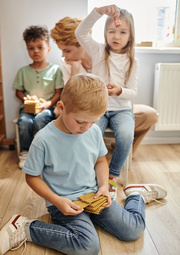The Benefits of Tactile Play for Children
Concerns regarding the effects of excessive screen time on children’s development have been raised in an era where digital screens and virtual experiences predominate. Parents face the ongoing challenge of balancing safe online activities and the need for real-world, hands-on engagement.
While limiting screen time is an important step, it leaves the question of how to engage children in healthy offline play effectively. Children can benefit greatly from tactile play, which stimulates the sense of touch and promotes physical interaction with their surroundings.
The benefits of tactile play can offset the negatives effects brought on by too much screen time. Let’s explore what this means and how tactile play can support a child’s overall growth, creativity, and well-being.
From Screen Time to Playtime
Re-embracing the joys of tactile play is becoming more significant in the digital age we live in, where screen time has become an integral part of our lives.
Tactile play emerges as a highly beneficial diversion from the often challenging world of monitor screens. Engaging in activities that involve the sense of touch, such as building with blocks, molding clay, or playing with various textures, not only provides an essential break from the constant bombardment of pixels but also encourages much needed sensory and cognitive development.
Additionally, it fosters the growth of fine motor skills, creativity, and problem-solving abilities, supporting a well-rounded and balanced approach to leisure that enhances rather than replaces the digital world. It provides a tangible experience that stimulates the imagination and improves mental and physical health, making it an essential component of a fulfilling and healthful lifestyle.
Benefits of Tactile Play
- Sensory Development: The development of the sense of touch—which is necessary for perceiving and interacting with the outside world—is promoted by tactile play. It develops children’s tactile sensitivity by allowing them to experiment with different textures, temperatures, and consistencies.
- Fine Motor Skills: Fine motor skills are strengthened through tactile play, which includes manipulating objects and squeezing and pinching them. These abilities are essential for writing, using utensils, and tying shoelaces.
- Cognitive Development: Through the development of hand-eye coordination, spatial awareness, and problem-solving abilities, tactile experiences foster cognitive development. Through touch, children learn to navigate and interpret their environment.
- Language Development: Interaction and communication with others are frequent components of tactile play. As they describe their experiences, pose questions, and have conversations about the textures, shapes, and sensations they come across, this can help a child’s language development.
- Creativity and Imagination: Through open-ended exploration, tactile play fosters imagination and creativity. With various materials, kids can construct buildings, write stories, and design original sensory experiences.
- Social Interaction: Playing with objects frequently entails collaboration and sharing, which fosters social skills. Group activities teach kids how to cooperate, take turns, and show empathy for others.
- Physical Well-being: Playing with textures can have physical benefits. Playing with plush toys, kneading dough, or digging in the sand are good ways to give your body exercise and sensory stimulation.
- Emotional Regulation: Tactile play can be soothing and comforting. It helps children manage stress and emotions by providing security and control over their environment. Plush toys, in particular, can offer comfort and companionship.
Introducing Plushie Toys: A Great Option For Tactile Activity
Plush toys are a fun and interesting option for tactile play that appeals to both children and adults because of their soft and cuddly exteriors.
These cuddly friends are available in an extensive range of forms, dimensions, and personas, rendering them an adaptable option for enjoyable and creative playtime. Plush toys, whether cuddly unicorns, teddy bears, or any other endearing stuffed animal, offer a tactile experience that piques the sense of touch and promotes comfort and tactile exploration.
With these delightful, tactile treasures, plush toys add a touch of warmth and whimsy to any play environment, encouraging creativity and fostering emotional connections.
Benefits Of Plushie Pulse Toys
Comfort and Security
Plushie pulse toys replicate the heartbeat sensation, which can be incredibly comforting for young children. This soothing rhythm can help ease separation anxiety and provide security, especially during bedtime or in unfamiliar environments.
Sleep Aid
Children can benefit from plush pulse toys as a sleep aid by using them to fall asleep and stay asleep longer. Healthy sleep patterns can be promoted by the comforting sensation that resembles a heartbeat.
Language Development
Conversations with plushie pulse toys can assist in language development in young children. Kids may talk to their toys, nurturing their communication and language skills.
Transition and Routine Support
Plushie pulse toys can help children cope with transitions, such as starting school or moving to a new home. The consistent presence of their comforting toy can make these changes more manageable.
Attachment and Bonding
Plushie pulse toys can become special companions for children, fostering a sense of attachment and emotional bonding. These attachments can be valuable for building a child’s self-esteem and social development.
Conclusion
It’s never been more vital parents, guardians, and educators to acknowledge and support the value of tactile play in a child’s everyday life. It establishes the groundwork for both lifelong learning and well-rounded development. Moreover, engaging in tactile play fosters curiosity, inventiveness, and critical thinking skills, in addition to advancing a more profound comprehension of their surroundings.
The benefits of tactile play for children are undeniable, and Plushie Pulse toys exemplify the perfect blend of innovation and safety in this realm. By engaging in tactile play with Plushie Pulse toys, children not only develop essential sensory and motor skills, they feed their creativity, imagination, and emotional well-being. Trust Plushie Pulse for kid-safe toys that not only provide a world of tactile exploration but also ensure your child’s safety, making playtime an enriching and worry-free experience.
Related Reading:
Learning by Play: The Role of Using Wooden Toys in the Development of Children’s Communication Skills





 Explore the Safe Search Engine -
Explore the Safe Search Engine -